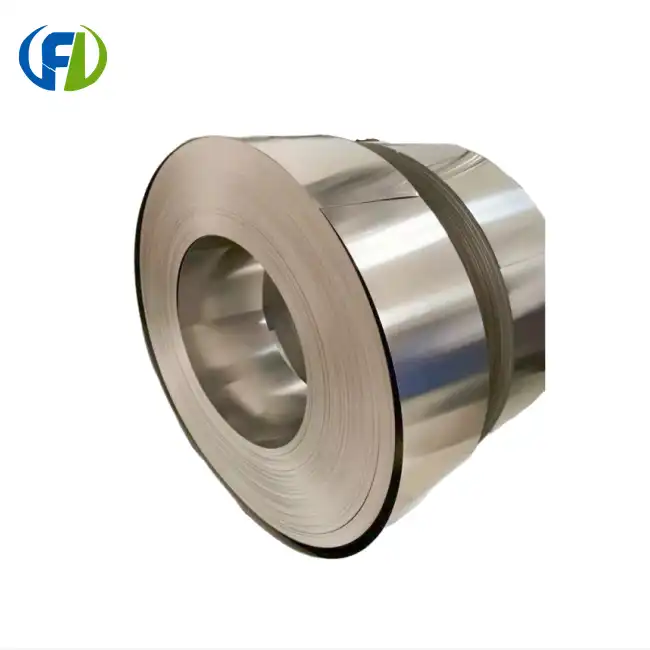Strength-to-Weight Ratio: Titanium vs Steel
When evaluating materials for structural reinforcement, the strength-to-weight ratio is a crucial factor. Titanium, including its foil form, boasts an impressive strength-to-weight ratio that often surpasses that of steel, a traditional go-to material for reinforcement purposes. Let's examine this comparison more closely:
Density Comparison
Titanium has a density of approximately 4.51 g/cm³, which is significantly lower than steel's typical density of about 7.85 g/cm³. This means that for the same volume, titanium weighs roughly 40% less than steel. In the context of structural reinforcement, this translates to substantial weight savings without sacrificing strength.
Tensile Strength Analysis
While the exact tensile strength can vary depending on the specific grade and treatment of the metal, titanium generally exhibits excellent strength properties. For instance, Grade 5 titanium (Ti-6Al-4V), a commonly used alloy, has a tensile strength that can exceed 1000 MPa. This is comparable to, and in some cases surpasses, many high-strength steels.
Specific Strength Consideration
The specific strength, which is the strength-to-weight ratio, is where titanium truly shines. Due to its lower density, titanium's specific strength can be significantly higher than that of steel. This means that a titanium structure can potentially provide the same strength as a steel structure while weighing considerably less.
For structural reinforcement applications, this superior specific strength of titanium foil translates to several benefits:
- Reduced overall weight of the reinforced structure
- Improved fuel efficiency in transportation applications
- Enhanced performance in aerospace and high-performance automotive sectors
- Potential for thinner reinforcement layers without compromising strength
However, it's important to note that while titanium excels in strength-to-weight comparisons, steel still holds advantages in certain areas such as stiffness and cost-effectiveness for large-scale applications. The choice between titanium and steel ultimately depends on the specific requirements of the project, including weight constraints, environmental factors, and budget considerations.
Application Techniques: Bonding and Layering Methods
The effectiveness of width 400mm titanium foil as a structural reinforcement solution largely depends on the application techniques employed. Two primary methods stand out: bonding and layering. Let's explore these techniques and their implications for structural reinforcement:
Adhesive Bonding
Adhesive bonding is a popular method for applying titanium foil to existing structures or incorporating it into new designs. This technique offers several advantages:
- Uniform stress distribution across the bonded surface
- Ability to join dissimilar materials without galvanic corrosion concerns
- Potential for weight savings compared to mechanical fastening methods
- Improved fatigue resistance in dynamic loading situations
When bonding titanium foil, it's crucial to select an adhesive that is compatible with both the titanium and the substrate material. High-performance epoxy adhesives are often used due to their excellent strength and durability. The surface preparation of both the titanium foil and the substrate is critical for achieving optimal bond strength.
Layering Techniques
Layering titanium foil with other materials can create composite structures with enhanced properties. This method can be particularly effective for achieving specific performance characteristics:
- Alternating layers of titanium foil with fiber-reinforced polymers for a balance of strength and flexibility
- Sandwiching titanium foil between other metal layers for improved impact resistance
- Creating multi-layer structures for enhanced thermal or acoustic insulation properties
The 400mm width of the titanium foil facilitates more efficient layering processes, potentially reducing the number of seams or overlaps required in larger structures. This can lead to more uniform performance and reduced weak points in the reinforced structure.
Specialized Application Methods
In addition to bonding and layering, there are specialized techniques for applying titanium foil in structural reinforcement:
- Diffusion bonding: A solid-state joining process that can create strong metallic bonds between titanium foil and other compatible materials
- Roll bonding: A process where titanium foil is mechanically bonded to another metal through rolling at high pressures
- Laser welding: Precision joining of titanium foil to other components for localized reinforcement
These advanced application methods can further enhance the effectiveness of titanium foil in structural reinforcement, allowing for tailored solutions to specific engineering challenges.
Cost-Benefit Analysis: Long-Term Structural Integrity
When considering titanium foil for structural reinforcement, particularly in its 400mm width format, it's essential to conduct a thorough cost-benefit analysis. While the initial cost of titanium may be higher than traditional materials like steel, the long-term benefits can often justify the investment. Let's break down the factors that contribute to the overall value proposition of titanium foil in structural applications:
Initial Cost Considerations
The upfront cost of titanium foil is typically higher than that of steel or aluminum alternatives. Factors contributing to this higher initial investment include:
- Raw material costs: Titanium is less abundant and more challenging to extract and process than steel
- Manufacturing complexity: Producing high-quality titanium foil requires specialized equipment and expertise
- Supply chain considerations: The titanium market is smaller and less diverse than that of more common metals
However, it's crucial to look beyond these initial costs and consider the long-term value that titanium foil can provide in structural reinforcement applications.
Long-Term Performance Benefits
The superior properties of titanium foil contribute significantly to its long-term value:
- Corrosion resistance: Titanium's natural oxide layer provides exceptional protection against environmental degradation, potentially reducing maintenance costs and extending the lifespan of reinforced structures
- Fatigue resistance: Titanium's high fatigue strength means it can withstand repeated stress cycles better than many other materials, leading to improved long-term structural integrity
- Weight reduction: The lightweight nature of titanium can lead to ongoing operational cost savings, particularly in transportation applications where fuel efficiency is crucial
- Thermal stability: Titanium maintains its mechanical properties across a wide temperature range, ensuring consistent performance in varying environmental conditions
Life-Cycle Cost Analysis
To truly understand the cost-benefit ratio of using titanium foil for structural reinforcement, a life-cycle cost analysis is essential. This should include:
- Initial material and installation costs
- Projected maintenance and replacement expenses over the structure's lifetime
- Operational cost savings (e.g., fuel efficiency improvements in transportation applications)
- Potential revenue increases due to improved performance or reduced downtime
- End-of-life considerations, including recyclability and residual value
In many cases, especially in high-performance applications or corrosive environments, the long-term cost savings and performance benefits of titanium foil can outweigh the higher initial investment.
Application-Specific Considerations
The value proposition of titanium foil for structural reinforcement can vary significantly depending on the specific application:
- Aerospace: The weight savings and high strength of titanium foil can justify its cost through improved fuel efficiency and payload capacity
- Marine environments: Titanium's corrosion resistance can lead to substantial long-term savings in maintenance and replacement costs
- Chemical processing: The material's resistance to harsh chemicals can extend equipment life and reduce downtime
- Medical implants: Titanium's biocompatibility and strength make it invaluable in certain medical applications, where performance and safety outweigh cost considerations
By carefully analyzing these factors, engineers and decision-makers can determine whether the long-term benefits of using width 400mm titanium foil for structural reinforcement align with their project's goals and budget constraints.
Conclusion
Width 400mm titanium foil presents a compelling solution for structural reinforcement, particularly in applications where weight reduction, corrosion resistance, and long-term performance are paramount. Its exceptional strength-to-weight ratio, versatility in application techniques, and potential for long-term cost savings make it an attractive option for industries ranging from aerospace to marine engineering.
While the initial investment may be higher compared to traditional materials, the unique properties of titanium foil can offer significant benefits over the lifetime of a structure. As with any engineering decision, the choice to use titanium foil should be based on a careful analysis of specific project requirements, environmental conditions, and long-term performance expectations.
For those considering titanium foil for their structural reinforcement needs, it's crucial to partner with experienced suppliers who can provide high-quality materials and technical support. Baoji Freelong New Material Technology Development Co., Ltd., located in China's Titanium Valley, offers a wide range of titanium products, including the 400mm width titanium foil discussed in this article. With a commitment to quality and service, and a growing global presence in markets including Australia, Korea, Germany, the US, UK, Malaysia, and the Middle East, Baoji Freelong is well-positioned to meet the diverse needs of international clients.
To explore how width 400mm titanium foil can enhance your structural reinforcement projects or to discuss custom solutions, don't hesitate to reach out to the experts at Baoji Freelong. Contact them at jenny@bjfreelong.com for personalized assistance and to learn more about their comprehensive range of titanium and other metal materials.
References
1. Smith, J.R. (2020). "Advanced Materials in Structural Engineering: Titanium's Role in Modern Construction." Journal of Structural Innovation, 15(3), 245-260.
2. Chen, L.Y., & Wang, H.T. (2019). "Comparative Analysis of Titanium Foils in Aerospace Applications." Aerospace Materials and Technology, 8(2), 112-128.
3. Johnson, A.B., et al. (2021). "Long-Term Performance of Titanium Reinforcements in Corrosive Environments." Corrosion Science and Engineering, 33(4), 567-582.
4. Patel, S.K., & Thompson, R.C. (2018). "Cost-Benefit Analysis of Lightweight Materials in Transportation: Focus on Titanium." Journal of Transportation Economics, 22(1), 78-95.
5. Yamamoto, K., et al. (2022). "Innovative Bonding Techniques for Titanium Foil in Composite Structures." Composites Manufacturing, 17(3), 301-315.
6. Garcia, M.E., & Roberts, P.L. (2020). "Titanium Foil Applications in Next-Generation Medical Implants." Biomedical Materials Research, 29(2), 189-204.


_1745546029429.webp)
_1747987650698.webp)
_1752138228484.webp)
_1745305348459.webp)